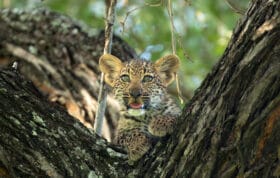I think when one first starts as a young and most likely naive ranger at Londolozi, you tend to feel there is a certain air of permanence about the leopards that inhabit the reserve. You see them as almost perennial characters in the ongoing drama that is life in the bush.
Sadly, that is not the case, as one soon gets to realise. Things change, the old go and the new come in.
Much as 2016 was a startling year in which the world lost many favourite sons and daughters, with names like Mohammed Ali, George Michael and David Bowie being just a few who are no longer with us, the Londolozi leopard ID kit also has a number of individuals who will no longer grace the “currently viewed” pages.
This is not meant to be a post of despair, but a celebration of some of the leopards that will no longer be filling the viewfinders of cameras as of 2016. Some were rarely seen, some were far more prominent in Londolozi leopard lore, yet all played their part in adding to the allure and mysticism that defines their species.
5:5 Male
Achieving immortality through being “adopted” by his grandmother, the 3:4 female, as a cub, the 5:5 male redefined some of the traditional beliefs about the presumed solitary existence of leopards. Observed sharing kills with his ageing grandmother in the twilight of her life, he made us look far more closely at the interrelationships between these marvelous cats.
Although we didn’t see him too much in the latter stages of his life, with most of his territory falling east of Londolozi, he became fairly nomadic towards the end, being ousted by younger males and sadly eventually being caught and mauled by the Tsalala pride in the Manyelethi River in the Winter of 2016. He succumbed to his wounds a few days later.
4:4 Male
The cat that in many ways defined perfectly what it means to be a wild African leopard, the 4:4 male’s life was forever in shadow. In an area defined by the viewing relationship we have with these big cats, it was a wonderfully refreshing thing to have an individual who almost refused to conform. Seemingly disdainful of our continued attempts to track him down and view him, the 4:4 male was unpredictable at best. His elusiveness only added to his appeal.
Like the 5:5 male, he fell victim to lions, and was mauled by the Mhangeni Breakway pride in October. At first it appeared that he had got away almost unscathed, but his apparently superficial wounds were graver than we feared, and he died on the night of 13th October.
Maliliwane female

Resting in a conveniently sloping knobthorn tree. The 2:2 spot pattern of the Maliliwane female along with her pink nose made her instantly recognisable.
One of a few leopards who weren’t often encountered on Londolozi, the Maliliwane female inhabited the north-eastern parts of the property. She would occasionally provide glorious sightings; hoisted kills in marula trees, cubs we didn’t even know she had, or simply walking down on of the boundary roads, but she was certainly not part of the mainstay of our leopard viewing here.
Sadly, her disappearance came at a time when she was known to be raising at least two young cubs. She was seen in a fairly poor and emaciated condition by rangers outside of Londolozi, and it was suspected that she may even have been bitten by a venomous snake of some sort. After no more sightings of her were had, it was accepted that she had died early in 2016.
Ximpalapala female
The first time I managed to capture a photo of this leopard, she had been treed by a pack of wild dogs and couldn’t descend to make her usual escape from the prying cameras that she forever seemed to evade. I think it was over two years later before I managed to get another one.
Notoriously shy around vehicles, she did seem to relax in her later years, and although she is almost certainly gone, her legacy lives on in her daughter the Tatowa female, who inhabits the central areas of Londolozi.
Like many leopards in the wild, we will never know what happened to her. Sightings of her simply dried up, and new, younger leopards began being seen in her territory. The last sighting of her was sometime in the winter of 2016.
Tutlwa female
Probably my two most serious encounters with leopards were both with the Tutlwa female. On both occasions, the outcome could have been very different, but somehow I was lucky enough to walk away with an intact skin. Given our shaky history, the Tutlwa female should not rank among my favourite leopards, but amongst all the females I have been lucky enough to view over the years, she still occupies the top spot, maybe exactly for that reason.
A leopard also infrequently seen, mainly owing to the inaccessibility of much of her territory, she was nevertheless relaxed around the Land Rovers, having been viewed frequently in her youth with her mother, the Vomba female.
Often to be found lying in the cool shade of a marula tree on the Ximpalapala crest, she provided many guests and rangers alike with unrivalled photographic opportunities.
Like the Ximpalapala female, sightings of her simply stopped towards the end of 2016, and given how much the Mhangeni Breakaway pride was favouring the Sand River in their movements at the time, it is not unlikely that the Tutlwa female met the same fate as the 4:4 male.
With the loss of some comes the moving in or maturing of others, so as in most things, change, it seems, is the only constant in the leopard population of Londolozi…
































sorry to hear that the leopards have left us. They are marvelous creatures, but like you said when the old die the new come in.
Beautifully written, On behalf of the Leopards,Thanks!
In the past years these were some of my favorites. Ximpalapala and 4:4 were interesting enigmas. It is best to celebrate their lives although I can’t help feeling that Tutlwa, 5:5 (Airstrip male) and Maliliwane (Kwatile) died too young ( all were about 10 y or less). The leopards of northern Londolozi have dramatically changed!…Here is a question… Have you seen the Maliliwane young female[daughter] in the past 3 months? Even before her mothers death she was exploring a lot. In the first 6 months after her Mums death she appeared to go on a grand tour of the Sabi Sands. She wandered off Londolozi to the NE. Then she returned to Londolozi in June and July 2016, as captured in photos by Callum Gowar (June 24) and Kevin Power(July 13). Then she went south and popped up on Kirkmans Kamp and a month later on Umkumbe reserve. Now I have lost her. Her facebook page (under her northern name Tsakani) does not have recent entries. I’m not sure if it is normal for a nearly 3 y old nomadic female to lay low this long, but I seem to remember the Ndzandzeni female keeping a low profile before she became territorial. Any help is appreciated (even if bad news).
Hi Brian,
To be honest I can’t think of a recent sighting of her offhand. I’ll ask among the team and see if anyone can recall one, but off the top of my head I seem to remember the last one being from quite a while ago.
Having said that, the area the Maliliwane female used to inhabit is without a territorial female that we know of, so it is very likely that SOME leopard is living there. Unoccupied territories in a densely populated leopard area like the Sabi Sands won’t stay unoccupied for very long. Maybe it is the young female who has set up residence and we just haven’t been seeing her…
It most often seems more often than not these Leopards often succumb to injuries from lions despite their ability to climb trees and get away from lions!How is it that you were able to have two nearly serious encounters with the Tutlwa female?Under what circumstances?
Hi Tim,
On both occasions we were tracking her on foot and I made a bad decision each time; thinking I knew what the situation was and not thinking things through. She had cubs with her both times and I nearly stepped on her, causing her to react very aggressively.
Did the 5:5 male leopard leave behind any offspring I really want to know